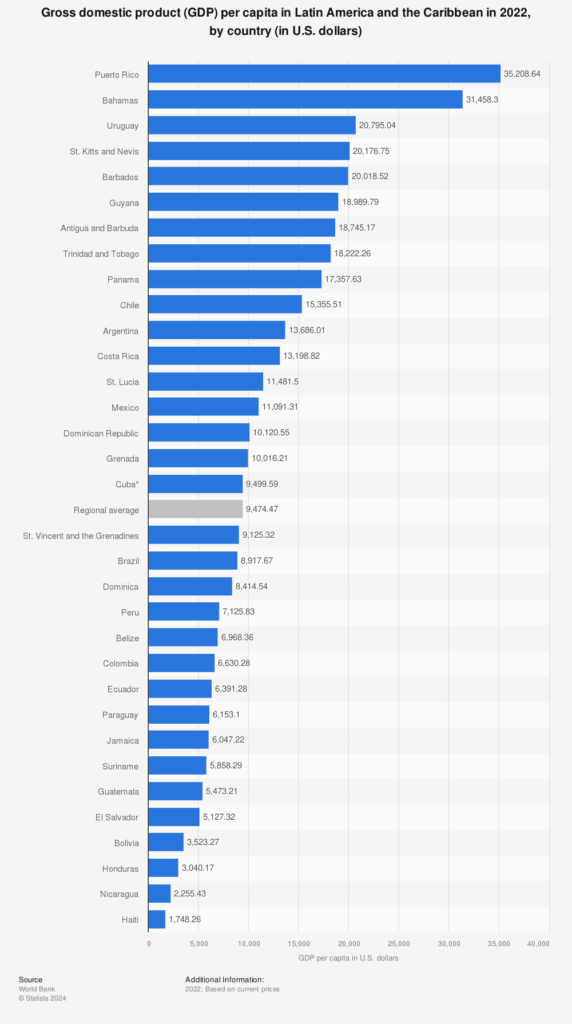We often compare Puerto Rico with the states of the United States. We see that Puerto Rico has fewer federal benefits, more unemployment, less annual income, more poverty, and fewer voting rights. The inequality is galling, and it’s wrong. It is certainly one of the big reasons that so many people choose to move to a state, and one of the big reasons that Puerto Rico ought to be a state.
But Puerto Rico is in a stronger position than its neighbors, and we should sometimes pay attention to that fact.
GDP
The chart below shows that the GDP per capita of Puerto Rico is more than three times higher than the average for Latin America and the Caribbean, higher than the GDPs of Chile, Argentina, Brazil, and Mexico — indeed, all the countries of Latin America and the Caribbean.
If Puerto Rico were a country rather than a territory of the United States (and had the same GDP it does now), it would be among the rich countries of the world.
HDI
Another way of comparing different places is to consider the HDI, or Human Development Index. This measure is calculated from metrics including the average annual income, life expectancy, and levels of education. Anything over 800 is considered high. The World Average is 0.739. Somalia is the world’s lowest at 0.380 and Switzerland is the highest at 0.967.
Puerto Rico’s HDI is 0.845. This is the #3 result for Latin America and the Caribbean, according to the United Nations database. Mexico’s is 0.781. Peru’s is 0.762. Haiti has an HDI of 0.559.
Corruption Perception Index
Each country is ranked on a scale of 0 (highly corrupt) to 100 (very clean). The higher the score, the less corruption a country is perceived to have. The CPI also categorizes countries into different corruption levels based on their scores:
- Very Clean: 80 or higher
- Clean: 60 to 79
- Moderately Corrupt: 40 to 59
- Somewhat Corrupt: 30 to 39
- Highly Corrupt: Below 30
Puerto Rico’s score on the Corruption Index is 63 points. Compare that with Argentina’s 37 points, Mexico’s 31, or Haiti’s 17 and Venezuela’s 13.
Health scores
Average life expectancy in Puerto Rico is 82 years. According to the United Nations, Chile is at the top of the list for Latin America and the Caribbean, with a life expectancy of 80 years. Mexico’s is 72, Peru’s is 69. Haiti’s is 66.
Infant mortality is one area where Puerto Rico is not in the lead. Puerto Rico’s infant mortality rate is 8%, and several countries have scores lower than that: Cuba’s is only 4%, and Chile’s is 7%. However, most of the nations in Latin America and the Caribbean have higher and indeed much higher rates. Mexico’s is 12%, Bolivia’s is 28%, and Haiti’s is 54%.
Some disease rates are higher in Puerto Rico than in the states, but once again Puerto Rico is on the lower end compared with countries in Latin America and the Caribbean. Puerto Rico actually has a lower rate for tuberculosis than the U.S. as a whole. Diabetes is unusually high in Puerto Rico, at 20%, but the average age of the population in Puerto Rico is higher than in other parts of the region.
Literacy rates
Puerto Rico’s literacy rate is over 92%, putting the Island third in all of Latin America and the Caribbean. Argentina is the winner with 99.51%, but Nicaragua has an 83% rate and Haiti is just under 62%.
Overall, Puerto Rico has numerous advantages due to its close ties to the U.S. However, it also faces challenges inherent in its territorial status. After more than a century as a U.S. territory, Puerto Rico should now be a state. With a level playing field, Puerto Rico has the capacity to shine.








No responses yet